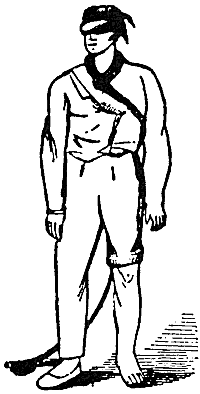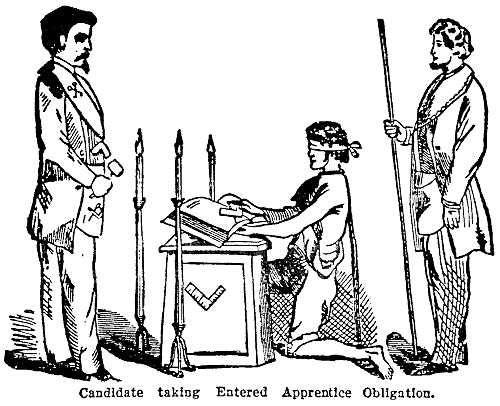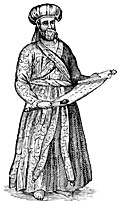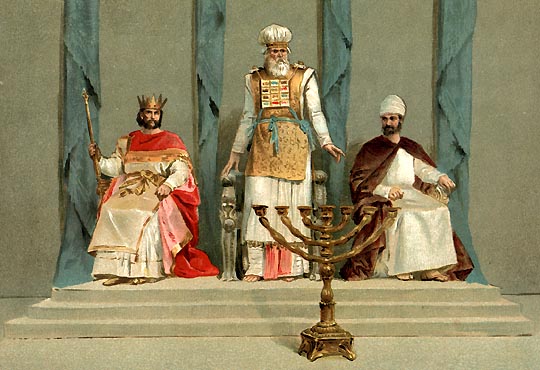Masonic hats
Posted: Wed Jul 04, 2012 2:36 am
From time to time, you see people making fun of the hats worn in the Mormon temple endowment ceremony. Why do they look the way they do?
A Google search on the masonic ceremony is not going to reveal very much on headgear. What types of hats have men worn in the past? Do any of these styles reflect what is worn by Mormon men in the temples today? I decided to take a look.
The findings of my little study are based on a book called, "What People Wore When: A Complete Illustrated History of Costume from Ancient Times to the Nineteenth Century for Every Level of Society" by Melissa, Leventon, 2008. I went through every image in this book and extracted out croppings showing mostly men's hats through the years found in Italy, Germany, France, England, and America. In some cases in which men's hats were not found in the book, I used a woman's hat that I felt might add to the results. Please refer to Exhibits A, B, and C for a visual summary of my findings.
I found that hats tended to be soft and fitting around the head from around 1000 AD to about the late 14th century. Later on, more shape was added through the use of billowing and puffing. This puffy aspect is similar to what you might see on today's pastry chef hats. This style appears to have been quite common for a time. In the middle of the 15th century, this puffy style became more pronounced. As seen in exhibit A, the Italian workman in 1450 wore a hat that you might find quite similar to the endowment hat. The working class people of this era wore white or off-white hats, while the rich had the luxury of choosing from a selection of bright colors. I assume that your working class folks including masons, carpenters, and cooks all wore something like the hat previously mentioned.
By the end of the 16th century, men of higher economic classes were beginning to wear stiff, wide-brimmed hats. Women of the working class, however, were still seen wearing the soft, puffy, white hats. Likely, the men of this class were wearing similar type hats but possibly more form fitting, like the turbine type hat shown on the Englishman of 1565 (exhibit 2). Although, the German baker in 1565 is seen wearing a billowing hat.
By the end of the 1800s, the only folks wearing a hat that resembles the early pastry chef type hats are the working class women. Notice the English carpenter in the 1800's (1867, to be exact).
I find it interesting how men in the early 1900's began once again to wear the soft puffy hats (i.e. flat cap). Women also started wearing these in the 1960's.
Exhibit A

Exhibit B

Exhibit C

Let's also look at some headgear worn by practitioners of freemasonry:
The man in the bottom-right corner:

Take a moment to view the headgear shown in this "The Structure of Freemasonry" image. Note especially that of the "Order of the Red Cross".
http://www.alliquippalodge.com/wp-conte ... nry-by.jpg
We may want to juxtapose the history of freemasonry on the history of hats in general. The construction of the Rosslyn Chapel in Scotland (1440–1490) provided the interface between the Knights Templar and Freemasonry. Accordingly, the First Degree and Mark Masonry was introduced by William Sinclair, the alleged first Grand Master and founder of Freemasonry. The historian Andrew Prescott has dated the The Halliwell Manuscript, or Regius Poem to the second quarter of the fifteenth century. These dates coincide nicely with the puffy hats being worn during this time, as shown in exhibit 1.
Yours,
Zee.
A Google search on the masonic ceremony is not going to reveal very much on headgear. What types of hats have men worn in the past? Do any of these styles reflect what is worn by Mormon men in the temples today? I decided to take a look.
The findings of my little study are based on a book called, "What People Wore When: A Complete Illustrated History of Costume from Ancient Times to the Nineteenth Century for Every Level of Society" by Melissa, Leventon, 2008. I went through every image in this book and extracted out croppings showing mostly men's hats through the years found in Italy, Germany, France, England, and America. In some cases in which men's hats were not found in the book, I used a woman's hat that I felt might add to the results. Please refer to Exhibits A, B, and C for a visual summary of my findings.
I found that hats tended to be soft and fitting around the head from around 1000 AD to about the late 14th century. Later on, more shape was added through the use of billowing and puffing. This puffy aspect is similar to what you might see on today's pastry chef hats. This style appears to have been quite common for a time. In the middle of the 15th century, this puffy style became more pronounced. As seen in exhibit A, the Italian workman in 1450 wore a hat that you might find quite similar to the endowment hat. The working class people of this era wore white or off-white hats, while the rich had the luxury of choosing from a selection of bright colors. I assume that your working class folks including masons, carpenters, and cooks all wore something like the hat previously mentioned.
By the end of the 16th century, men of higher economic classes were beginning to wear stiff, wide-brimmed hats. Women of the working class, however, were still seen wearing the soft, puffy, white hats. Likely, the men of this class were wearing similar type hats but possibly more form fitting, like the turbine type hat shown on the Englishman of 1565 (exhibit 2). Although, the German baker in 1565 is seen wearing a billowing hat.
By the end of the 1800s, the only folks wearing a hat that resembles the early pastry chef type hats are the working class women. Notice the English carpenter in the 1800's (1867, to be exact).
I find it interesting how men in the early 1900's began once again to wear the soft puffy hats (i.e. flat cap). Women also started wearing these in the 1960's.
Exhibit A

Exhibit B

Exhibit C

Let's also look at some headgear worn by practitioners of freemasonry:
The man in the bottom-right corner:

Take a moment to view the headgear shown in this "The Structure of Freemasonry" image. Note especially that of the "Order of the Red Cross".
http://www.alliquippalodge.com/wp-conte ... nry-by.jpg
We may want to juxtapose the history of freemasonry on the history of hats in general. The construction of the Rosslyn Chapel in Scotland (1440–1490) provided the interface between the Knights Templar and Freemasonry. Accordingly, the First Degree and Mark Masonry was introduced by William Sinclair, the alleged first Grand Master and founder of Freemasonry. The historian Andrew Prescott has dated the The Halliwell Manuscript, or Regius Poem to the second quarter of the fifteenth century. These dates coincide nicely with the puffy hats being worn during this time, as shown in exhibit 1.
Yours,
Zee.










